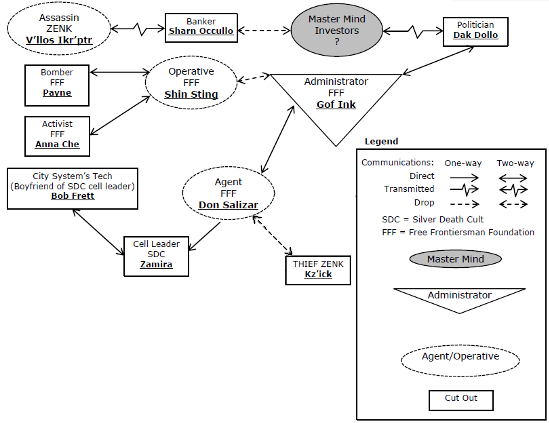By Thomas Verreault/jedion357
Editor’s Note: The inspiration for this article came from Top Secret published by TSR Inc.
Octopus networks are made up of NPC’s fulfilling roles. The roles are mastermind, administrators, agents and cut outs.
- Masterminds are the brain of the octopus network, conceiving the plot and initiating it. Without the mastermind the network will stagnate or unravel. He is the key to the whole network. If the mastermind is taken out, the network will crumble into chaos.
- Administrators work beneath the mastermind and above the actual field operatives. They are the managers who implement the plot. They maintain a legal cover and rarely commit illegal actions. They are often unidentifiable by the agents andoperatives they manage. Administrators have in-depth knowledge of their area but may not be aware of other administrators under the masterminds’ control. Remember, it’s the mastermind that moves the chess pieces within his network. Twist: Truly brilliant mastermind may have several octopus networks which, at some point are connected through an administrator.
- Agents/Operatives are the dirty work specialist. They are the ones that get things done and perform the illegal actions. They report to a single administrator, are extremely committed and will aggressively defend the administrator and their portion of the network. Agents have a number of cut outs at their disposal.
- Cut Outs are used to do "leg work" and know very little of the network. All they usually know is that someone told them to do something. They're used in a network to protect the mastermind, administrators, and the agents from detection because they're more expendable; hence the name "cut out." Sometimes they are referred to as thugs, mooks and goons.
Communications Within The Octopus Network
Communications between the members of a network are either one-way or two-way.
- Two-way communications – either party can initiate contact.
- One-way communication - only one member can contact the other in the network.
It’s impossible to list all the methods of communication possible. Communications can be categorized into the following
- Indirect – a message that everyone can see but is intended for a single person or group. For instance, billboard signs, TV ads, graffiti, etc.
- Direct – message is it intended for a person or group that is communicated directly. For instance, ear-to-mouth, smell, touch, etc.
- Transmitted – messages other than ear-tomouth, they use public or private communications networks.
- Drop – Message dropped in a public location for pick up either immediately (briefcase hand to hand) or later (P.O. Box, locker, etc.).
